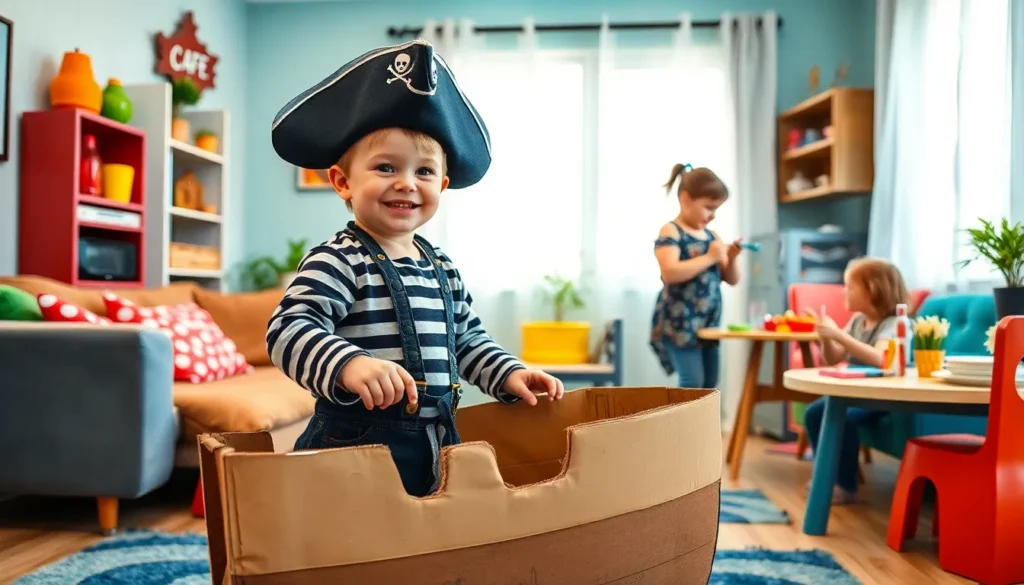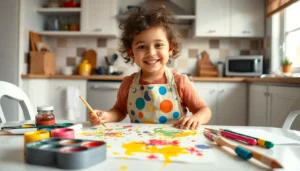Table of Contents
ToggleImagine a world where your living room transforms into a bustling café or a pirate ship sailing the high seas. Pretend play setups are not just a fun escape; they’re a gateway to creativity, problem-solving, and social skills. Kids dive into imaginative realms, and parents get a front-row seat to the magic of make-believe.
Understanding Pretend Play Setups
Pretend play setups foster creativity and imaginative thinking in children, enhancing their overall development. Creating various environments encourages kids to explore different roles and scenarios.
Definition and Importance
Pretend play setups refer to designated areas where children engage in imaginative role-playing. These setups often mimic real-life situations, like kitchens or shops. Importance lies in their ability to support cognitive growth. By participating in these activities, children learn to express themselves, test social norms, and develop empathy. Engaging in pretend play cultivates communication skills, allowing kids to narrate stories and negotiate roles with peers. This structured play not only boosts linguistic abilities but also creates opportunities for fun social interactions.
Developmental Benefits
Developmental benefits of pretend play are vast and impactful. Social skills emerge as children interact with peers, learning cooperation and negotiation. Imagination expands when kids adopt various roles, whether as parents, doctors, or superheroes. Problem-solving abilities also improve through the creation of scenarios requiring critical thinking. Emotional intelligence develops as children navigate feelings and perspectives, enhancing empathy. Overall, imaginative play fosters a sense of autonomy and boosts self-esteem, crucial elements for healthy development. Encouraging pretend play setups allows for holistic growth, impacting numerous areas of childhood learning.
Types of Pretend Play Setups
Pretend play setups offer diverse opportunities for imaginative exploration. Each setup serves different developmental purposes.
Home Corner Setup
Home corners mimic everyday life, allowing children to engage in domestic scenarios. Children might pretend to cook, shop, or care for babies, experiencing routine activities. This setup promotes understanding of household roles and responsibilities. Kids practice cooperation as they share tasks like setting the table or tidying up. Through role-playing, they develop communication skills while expressing their emotions. Resources such as play kitchens, grocery items, and toy furniture enhance the experience. Emulating real-life environments prepares kids for future responsibilities and nurtures their social skills.
Outdoor Adventure Setup
Outdoor adventure setups encourage explorations of nature and physical activity. Children might create pirate ships or camping sites, sparking their imagination. Engaging with natural elements enhances their connection to the environment. Kids develop problem-solving skills as they navigate obstacles, build forts, or find hidden treasures. Tools like binoculars or bug catchers can elevate their experiences. Such setups promote teamwork as children collaborate on imaginative quests. Freedom of exploration fosters independence while creating memorable adventures that inspire creativity and resilience.
Fantasy Theme Setup
Fantasy theme setups immerse kids in imaginary worlds like castles or enchanted forests. These spaces ignite creativity through role-playing as princesses, dragons, or superheroes. Every child can develop a narrative, enriching their storytelling abilities. Props like costumes, puppet theaters, and magical objects encourage dramatic play. Exploration of these themes fosters empathy as children assume diverse perspectives. Character interactions help develop social skills and emotional understanding. Imaginative scenarios promote problem-solving as kids devise solutions to fantastical challenges, enriching their play experience.
Creating Effective Pretend Play Setups
Choosing the right materials can enhance pretend play setups significantly. Select items that inspire creativity and imagination. Incorporate everyday objects like kitchen utensils, fabric pieces, and boxes. These elements encourage role-playing while being safe and engaging. Consider using props that resonate with children’s interests, such as costumes or themed accessories. Using realistic items helps children connect with their play scenarios, facilitating deeper engagement.
Designing safe spaces is crucial for promoting imaginative play. Ensure the play area is free from hazards, like sharp objects or heavy furniture. Utilize soft mats or rugs to cushion children during active play. Space should allow easy movement to prevent injuries. Arrange furniture to create defined zones for different scenarios, such as a kitchen corner or a reading nook. Encourage supervision during play to ensure safety while allowing freedom for creativity.
Tips for Enhancing Pretend Play Experiences
Enhancing pretend play experiences requires thoughtful strategies that support children’s creativity and engagement.
Encouraging Imagination
Incorporating open-ended materials sparks children’s imaginations. Items like cardboard boxes, fabric scraps, and art supplies invite limitless possibilities. Setting up themed areas allows kids to dive into different narratives, from a pirate ship to a space station. Providing props that align with their interests can deepen engagement. Encouraging children to create their own stories promotes narrative skills and fosters original thinking. Leaving space for collaboration enriches play, as it encourages teamwork and social skills. Inviting feedback from children about what they wish to include in their setups fosters a sense of ownership and investment in their play.
Involving Caregivers and Educators
Collaboration with caregivers and educators enhances the pretend play experience. Involving adults in play provides guidance while maintaining children’s independence. Encouraging caregivers to add their own ideas can expand play themes and concepts. Educators can suggest appropriate scenarios based on the children’s developmental stages. Joint participation helps children feel supported and encourages them to take risks in their play. Creating a space for adults to observe and engage fosters a collaborative atmosphere. Organizing workshops to share ideas on enhancing play setups can build community support and ensure the effectiveness of pretend play experiences.
Conclusion
Pretend play setups are invaluable tools for nurturing children’s growth and development. By creating spaces that encourage imaginative role-playing, parents and caregivers can significantly enhance a child’s creativity and social skills. These setups not only provide entertainment but also foster essential life skills that will benefit children as they grow.
As children engage in various scenarios, they learn to navigate emotions and develop empathy through shared experiences. Encouraging this kind of play helps children build confidence and a sense of community. Ultimately, investing time and resources into effective pretend play setups lays the foundation for a well-rounded and imaginative future.








